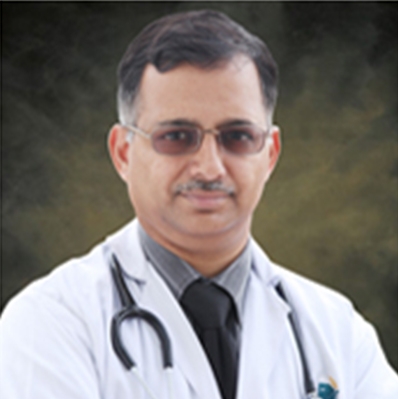 100%
100%
DR VIKRAM KAMATH
Neurologist
- Fees: INR 900
-
Friday 10:00 AM - 2:00 PM
(See all timing)Monday 10:00 AM - 2:00 PM,
Wednesday 10:00 AM - 2:00 PM,
Friday 10:00 AM - 2:00 PM
Introduction
Dr. Vikram Kamath is one of the best Neurologist in Bangalore and has an experience of 15 years in this field. Dr. Vikram Kamath, Senior consultant has vast experience in the field of Neurology. Research and Publications Autonomic dysfunction in Wilson’s disease-a clinical and electrophysiological study. S Meenakshi-Sundaram, A.B.Taly, V.Kamath, G.R.Arunodaya, S.Rao and H.S.Swamy. Clinical Autonomic Research (2002) 12:185-189. Phenobarbitone induced gingival hyperplasia-case report. S.Sinha, V.Kamath, A.B.Taly, G.R.Arunodaya. J Neurol Neurosurg Psychiatry (2002) 73: 601-602. Functional MR imaging of hand motor cortex in a case of persistent mirror movement. P.N.Jayakumar, J.M.E.Kavoor, S.G.Srikanth, A.B.Taly, V.Kamath. Neurology India (2003) 51: 94-97. Acute Painful Peripheral Neuropathy due to Metronidazole. G R K Sarma, V. Kamath Neurology India (June 2005) Vol. 53: pp. 372-373. Remitting-relapsing Subacute Sclerosing Panencephalitis (SSPE). Case description and mini-review. V Kamath, A B Taly, S Sinha, et al. Ann Ind Acad Neurology (2005) 8:101-104. A case of Parkinsonism worsened by losartan: a probable new adverse effect. Authors: G R K Sarma, Vikram Kamath, Thomas Mathew, A K Roy. Movement disorders (June 2008) 23(7):1055. Subdural hematoma, subarachnoid hemorrhage and intracerebral parenchymal hemorrhage secondary to Cerebral Sinovenous Thrombosis: A rare combination. Thomas Mathew, G.R.K Sarma, Vikram Kamath, A.K. Roy. Neurology India. (Jan 2007) 55(4):438-9. Thesis on Dysautonomias in spinal cord disorders: clinical and electrophysiological profile (submitted to NIMHANS in partial fulfillment for the award of D.M. degree in Neurology). Life member of Indian Academy of Neurology (IAN), Neurological Society of India (NSI) and Bangalore Neurological Society (BNS).
Hospital Associations
APOLLO HOSPITAL BANNERGHATTA ROAD
Services/Interest
- Stroke
- Demyelinating diseases
- Neuroinfections.
Experience
Dr. Vikram Kamath has an experience of 15 years in this field.
Awards and Recognitions
Functional MR imaging of hand motor cortex in a case of persistent mirror movement. P.N.Jayakumar, J.M.E.Kavoor, S.G.Srikanth, A.B.Taly, V.Kamath. Neurology India (2003) 51: 94-97. Acute Painful Peripheral Neuropathy due to Metronidazole. G R K Sarma, V. Kamath Neurology India (June 2005) Vol. 53: pp. 372-373. Remitting-relapsing Subacute Sclerosing Panencephalitis (SSPE). Case description and mini-review. V Kamath, A B Taly, S Sinha, et al. Ann Ind Acad Neurology (2005) 8:101-104. A case of Parkinsonism worsened by losartan: a probable new adverse effect. Authors: G R K Sarma, Vikram Kamath, Thomas Mathew, A K Roy. Movement disorders (June 2008) 23(7):1055. Subdural hematoma, subarachnoid hemorrhage and intracerebral parenchymal hemorrhage secondary to Cerebral Sinovenous Thrombosis: A rare combination. Thomas Mathew, G.R.K Sarma, Vikram Kamath, A.K. Roy. Neurology India. (Jan 2007) 55(4):438-9. Thesis on Dysautonomias in spinal cord disorders: clinical and electrophysiological profile (submitted to NIMHANS in partial fulfillment for the award of D.M. degree in Neurology). Life member of Indian Academy of Neurology (IAN), Neurological Society of India (NSI) and Bangalore Neurological Society (BNS).
Education
MBBS, DM(Neurology)
I Speak
English, Hindi
Feedback For Dr Vikram Kamath
Write FeedbackMalti P
(01 Oct 2022)K Lokesh Gowda
(30 Aug 2022)Anuradha Bhagawan
(07 Jul 2022)Vimal Gupta
(28 Jun 2022)Apollo Hospital Bannerghatta Road Timing
Monday
10:00 AM - 2:00 PM
Wednesday
10:00 AM - 2:00 PM
Friday
10:00 AM - 2:00 PM
What is a neurologist?
Neurology is the branch of medicine that focuses on study and treatment of disorders of the nervous system. A neurologist is a physician who specializes in treating diseases of the nervous system which is made of two parts: the central and peripheral nervous system. It includes the brain and spinal cord.
Before neurologists can practice, they must:
- Graduate from medical school
- Complete an internship
- Receive 3 years of training in a Neurology residency program.
What are the diseases treated by the neurologists?
- Stroke and Neurological trauma
- Tumors of the nervous system
- Infections of the nervous system
- Multiple sclerosis and other autoimmune diseases
- Epilepsy and Headaches
- Peripheral nerve disease
- Neuromuscular diseases
- Dementia
- Movement and Sleep disorders
When should you go and see a neurologist?
A person should go and see a neurologist if he is suffering from:
- Severe headaches and chronic pain.
- Dizziness, numbness or tingling.
- Chronic weakness.
- Problems with movement and vision problems.
- Seizures
- Difficulty in thinking and sleep problems.
What tests are done by a neurologist?
Tests performed by neurologists are Neurological Diagnostic Tests, Brainstem Auditory Evoked Response (BAER) Test, Carotid Duplex (Carotid Ultrasound), Cerebral Angiography (Also Called Vertebral Angiogram or Carotid Angiogram), Computed Tomography (CT or CAT scan), Discography, Doppler Ultrasound, Electroencephalogram (EEG), Electromyography (EMG), Intrathecal Contrast Enhanced CAT Scan, Lumbar Puncture (Spinal Tap), Magnetic Resonance Imaging (MRI), Magnetic Resonance Angiogram (MRA)/Magnetic Resonance Venogram (MRV), Myelogram, Nerve Conduction Study, Oculoplethysmography (OPG), Positron Emission Tomography (PET) Scan, Selective Nerve Root Block, Single Photon Emission Computed Tomography (SPECT) Scan, and Somatosensory Evoked Response (SSER) Test.
What is the difference between neurologist and psychiatrist?
Neurological practice relies on the field of neuroscience, the scientific study of the nervous system while psychiatry is the medical specialty devoted to the diagnosis, prevention, study, and treatment of mental disorders. A neurologist is a physician specializing in the treatment of exogenous (organic) disorders that are caused by organic brain damage, and psychiatrist is a physician that treats endogenous disorders that are not attributable to any external or environmental factor. They are due to biological, physiological, genetic mental reactions, states, and development, which is caused by the internal constitutional disorder.
How to prepare for your first appointment with a neurologist?
Write down the symptoms and other health information, including medications, previous illnesses, allergies, and your family's history of the disease. Make a list of your questions. Have the previous test results sent in advance, or take them with you. Don't be hesitant to ask questions if you're confused about something. Make sure you understand the diagnosis and treatment and any further steps that have been suggested you need to take.
